Wes Hauch and Tim Walker dish out bleak brutality and darkened death metal (with a side of moodier moments) by way of choice Ibanez shredsicles, a signature set of Seymour Duncan firebreathers, and meticulously managed modelers dialed for pure power, diabolical dynamics, and technical ecstasy.
Being in a band can be a mercurial experience. Internal combustion and outside factors can make any promising group crash and burn before reaching cruising altitude. Plus, it’s never been easier to replace bothersome bandmates with plugins and software. So in 2015, Wes Hauch paused all his various death-metal day jobs (formerly with the Faceless, Thy Art Is Murder, Glass Casket, and Black Crown Initiate) and started Alluvial as a brain break and artistic challenge to scratch itches previously unreachable.
“I started to think about putting a band together that was everything that I missed about what wasn’t going on in heavy music,” Hauch told PG in 2021.
He teamed up with fellow shredder Keith Merrow and the duo put their darkest emotions into the instrumental project. They built everything from the ground up and The Deep Longing for Annihilation was self-released in 2017. It (beautifully) bludgeoned the ears of Animals as Leaders’ Javier Reyes, who wanted to take out Alluvial on tour. And now Hauch needed a band… his band.
While writing his next batch of material that would ultimately evolve into 2021’s Sarcoma (released on Nuclear Blast), Hauch recruited singer Kevin Muller (Suffocation and The Merciless Concept) and drummer Matt Guglielmo to fill everything out. The results are like someone dropped a Shelby GT500 inside an excavator primed to pummel granite. Death metal might be its blanket, but there’s more lurking under the covers. The second album has moments of blitzkrieg (“Sarcoma”), allusions to Greg Ginn playing in an extreme metal band (“The Putrid Sunrise”), and even hallucinatory respites (“40 Stories”).
“I’m always trying to find something that’s a different sort of rhythmic motif for metal, just to see if it's going to work, and if it's going to make people feel it, or if it’s going to make me feel it,” stated Hauch.
Now Alluvial is a full four horsemen with bassist Tim Walker and drummer Zach Dean, who both have been playing live with Hauch and Muller and contributed to their forthcoming EP Death Is But A Door.
“I wanted to have a band where we can write meaningful yet action-packed songs. Something that is terrifying but breaks your heart at the same time. I think we’ll always chase that, but we want to find new ways to be heavy” Hauch reflected.
Alluvial seems to be avoiding any turbulence during their ascent with just one thing in mind: gatherings through gain.
“I want to go play with everyone … all the people that enjoy the message that’s usually coupled with that distorted guitar,” said Hauch. “And for anyone who’s checking this out, I want to say thank you, because it’s hard to get anyone to participate in your art these days. The fact that people are, I’m very grateful.”
Ahead of Alluvial’s opening slot supporting Intervals and Tesseract at Nashville’s Brooklyn Bowl, founding guitarist (and lead headbanger) Wes Hauch and bassist Tim Walker welcomed PG’s Chris Kies onstage to explore their tools of destruction. Hauch highlighted his main 7-string Ibanez shred sticks—including his signature set of Seymour Duncan Jupiter Rails humbuckers—and detailed the great lengths he went to capture his favorite Boogie and Friedman sounds in his Kemper for the band’s “get-the-fuck-out-of-the-way rig.” Then Walker quickly spotlighted his Ibanez blackout 5-string bass—and the mods he’s made—plus explained the motive behind matching a rackmount Helix with a fridge-sized Ampeg 6x10.
Brought to you by D'Addario.
"The Coolest Shape Gibson Never Thought Of"
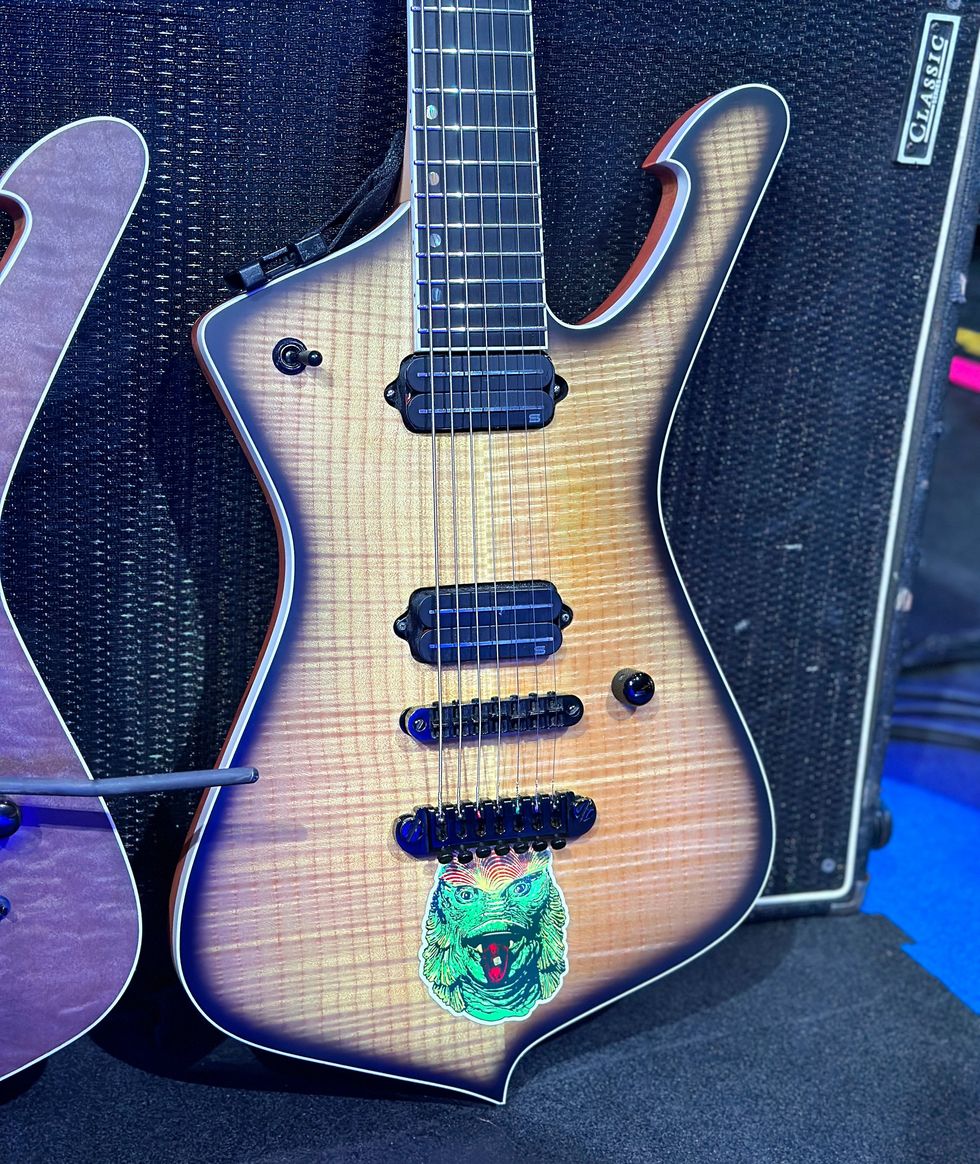
Hauch has had a long relationship with Ibanez. He’s been using their extended-range, 7-string monsters for years. He landed on the Iceman shape because of friend and contemporary Wacław “Vogg” Kiełtyka of Decapitated. (In our Rig Rundown video, he of course acknowledges the influences that Paul Stanley and White Zombie’s Jay Yuenger played in the decision, too.)
“I look at this like the coolest shape Gibson never thought of,” remarks Hauch. “This is the best things about a Les Paul and Explorer in a pretty unique shape. It feels cozier to me and I can wear it at ‘regulation cool’ height and still play well [laughs].”
This L.A. Custom Shop creation has a flame maple top over a mahogany body, a maple neck with a purpleheart stringer up the middle, ebony fretboard, and 27" scale length. Some mods he’s made to it include swapping out the standard tune-o-matic-style bridge and for an ABM 2507b that has fine tuners. With this addition, Hauch claims this to be his “most functional guitar,” allowing him to pull off the entire set if needed.
The heartbeat of this colossus comes from Hauch’s signature Seymour Duncan Jupiter Rails that took over two years to develop. It has dual stainless-steel rail poles, a ceramic magnet and a finely-tuned, high-output wind that aims to deliver an aggressive midrange-focused attack, evenly balanced string response, and clarity. Hauch notes that he purposely rolled off the low end on the pickup so it reacts better, and he can effectively use resonance controls or EQ parameters later in his chain.
The green machine typically rides in G#-standard tuning (G#–C#–F#–B–E–G#–C#) and takes a set of D’Addario NYXL1052 Light Top/Heavy Bottom strings plus a .068 on the low-B string.
Nosferatu
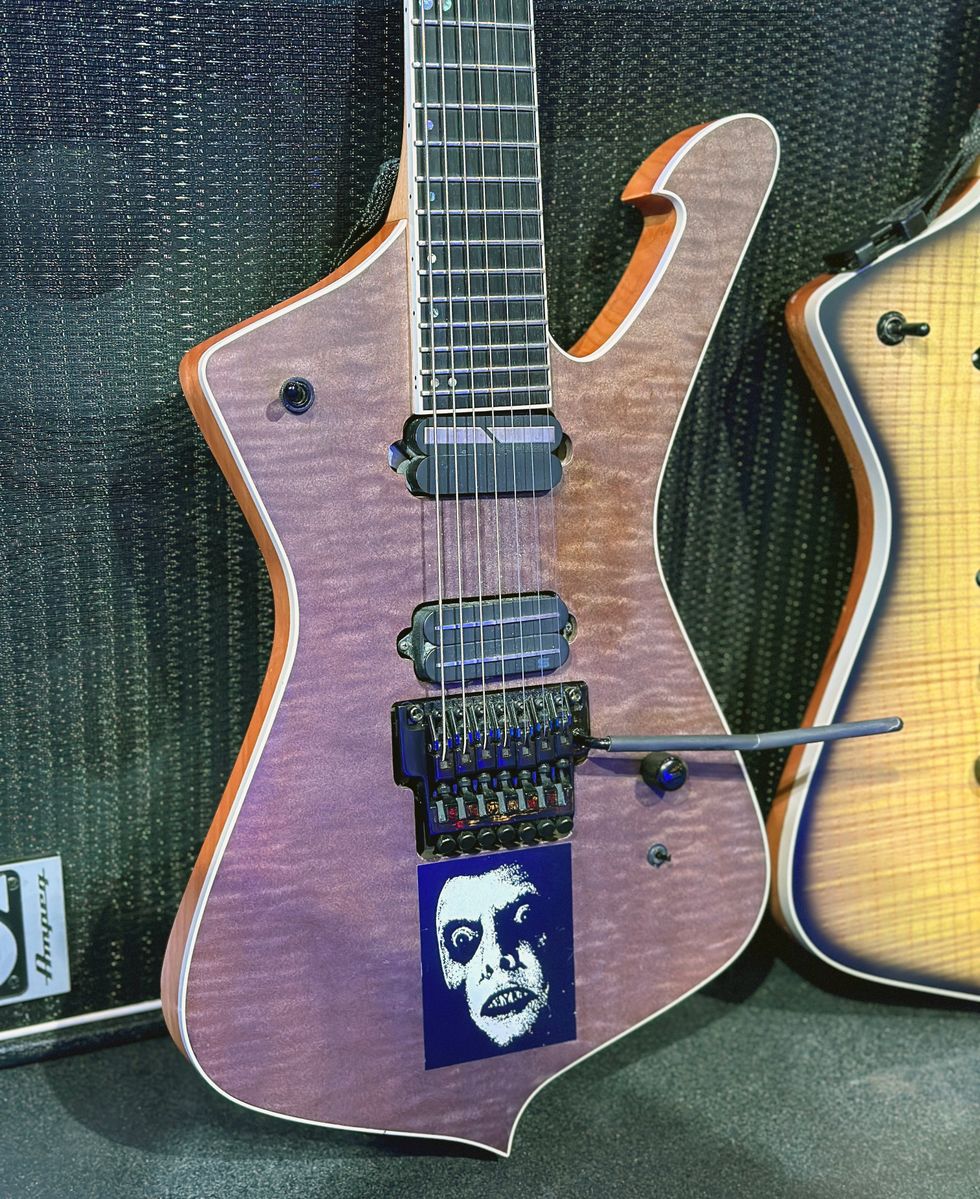
Here is Swamp Thing’s little brother that measures in with a standard 25.5" scale length, a smaller mahogany body that’s capped with a curly maple lid, and a Sustainiac pickup in the neck (alongside Hauch’s Jupiter in the bridge). The added 3-way switch toggles between modes for the Sustainiac: unison, a fifth, and octave up.
During the Rundown Hauch states that he used this Iceman for all the solos on Alluvial’s forthcoming EP Death Is But A Door. It usually stays in standard tuning and takes D’Addario NYXL1052 Light Top/Heavy Bottom strings plus a .062 for the low-B string.Blue Me Away
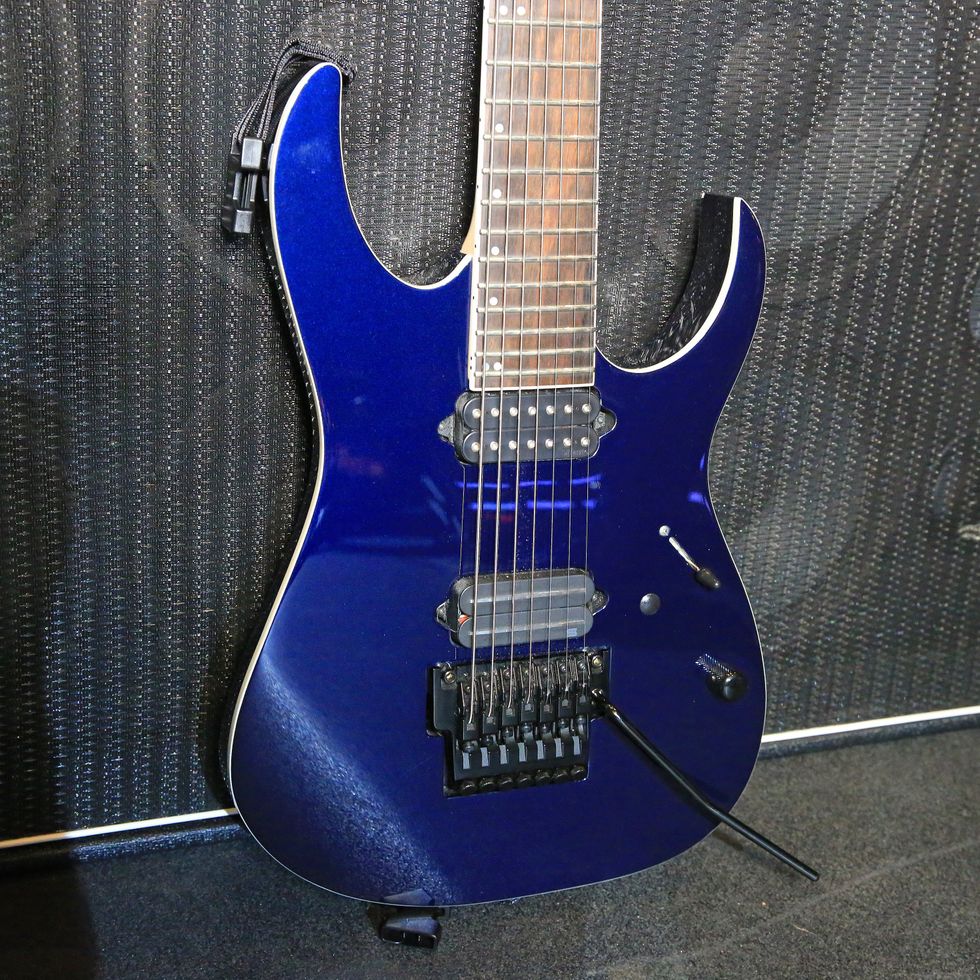
This Ibanez Prestige RG2027XL is a favorite for Hauch, who claims the guitars are “out of control sick. I had to get two!” The RG has a basswood body, a 5-piece maple-and-wenge neck in the Wizard-7 profile, a bound rosewood fretboard, a 27" scale length, and is finished in a striking dark tide blue.
The few changes he’s made include trading out the bridge DiMarzio Fusion Edge 7 humbucker for his Duncan Jupiter Rails and substituting the stock trem springs with some from FU-Tone.
Night Prowler
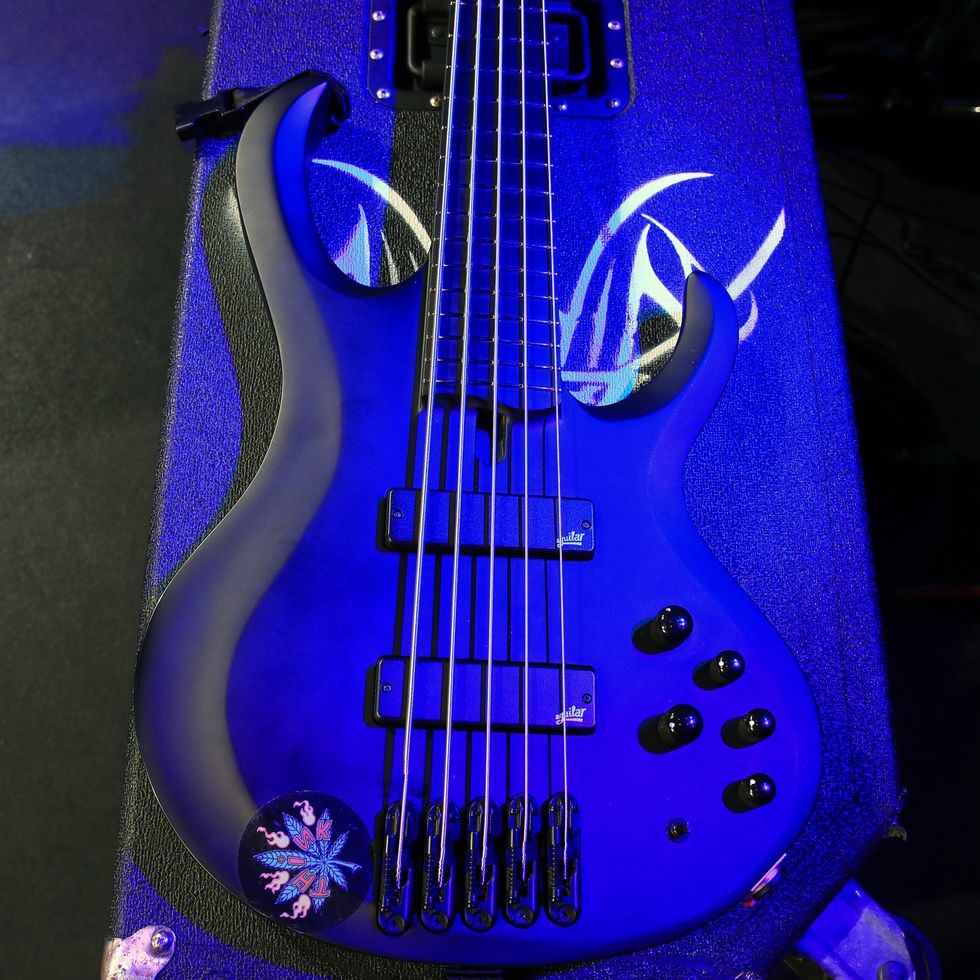
Alluvial bassist Tim Walker travels with this single Ibanez Iron Label BTB652EX that is built with an okume body, 5-piece maple-and-walnut neck (with thru construction and a 35" scale length), an ebonol fretboard, Bartolini BH2 pickups, and an onboard 3-band EQ with 3-way mid-frequency switch. He prefers to play a custom set of D’Addario NYXL bass strings (.050–.145) and attacks them with a Dunlop Tortex .73 mm pick.
One thing Walker has done since buying the Iron Label 5-string is remove the BH2s for a set of Aguilar DCB-D2 Dual Ceramic pickups that gives him a little more attack and an even frequency response.
Exit ... Stage Left!
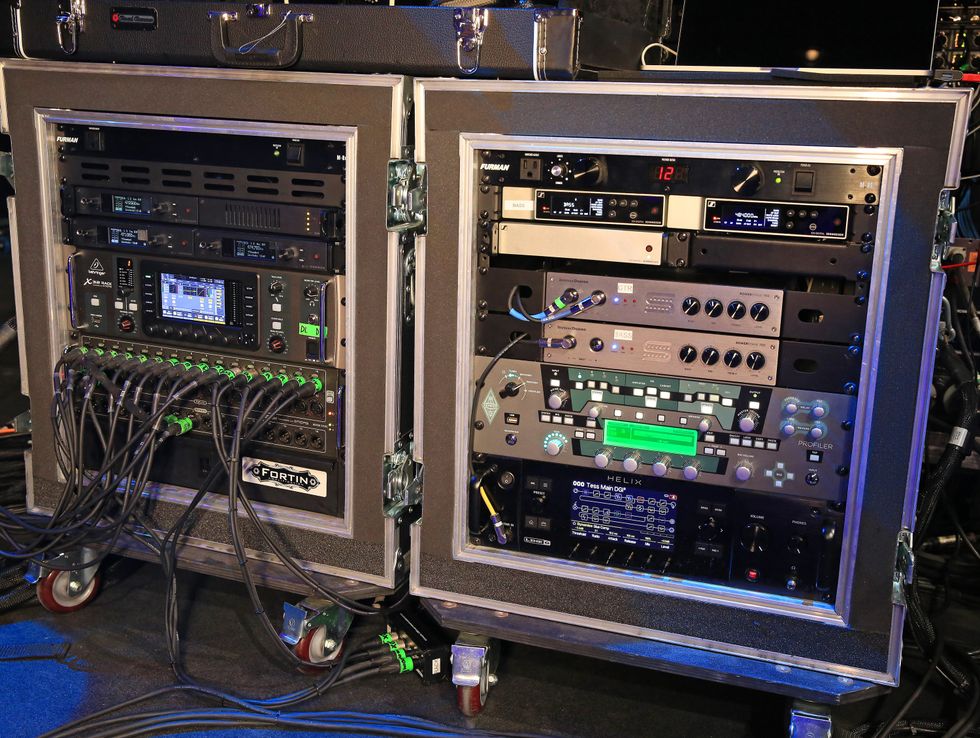
For the sake of efficiency as an opener and reduced travel costs, Hauch built up this streamlined setup he coined the “get-the-fuck-out-of-the-way rig.” He customized the Kemper Profiler by capturing his Mesa/Boogie Dual Rectifier Revision G and Friedman JJ-100 Jerry Cantrell heads, so he feels at home while on the road. Hauch’s favorite part of the simplified digital solution: “It turns on every day [laughs].” (You can download Wes’ profiles of these amps and others here.)
Tim’s side of the tonal equation has a Line 6 Helix Rack that he’s been loving for over five years. He digs the platform’s intuitive layout that’s enabled him to take a studio approach to separately sculpt his bass sound in low-, mid-, and top-end frequencies that are then all blendable at the end of his chain. His main tones are based around Cali Bass (Mesa/Boogie M9) and Obsidian 7000 (Darkglass Microtubes B7K Ultra) models. He’s selected a 3 Sigma Audio cab IR based on a Mesa/Boogie PowerHouse 6x10. Additionally, he configures several patches and blocks within each song for the band’s setlist. He’s got it pretty maxed out and the Helix hasn’t begged for mercy yet.
Both Hauch and Walker utilize Seymour Duncan PowerStage 700 to power cabinets onstage, Sennheiser EW-D CI1 SET Digital Wireless Instrument Systems to freely roam the stage, Sennheiser EW IEM G4 Wireless in-ear monitors, and a Behringer X32 Rack to mix their live sound.
Noise Floor

Here’s a closeup look at what Hauch and Walker have at their backs and feet. Up top is Walker’s Ampeg SVT-610HLF bass cab equipped with Eminence 10" speakers. The middle is a pair of Hauch’s EVH 5150IIIS EL34 4x12 cabinets each loaded with four 12" Celestion G12 EVH 20W speakers. And at the bottom is Wes’ Kemper Profiler Remote controller, an old Digitech Whammy WH-1, and a Dunlop Volume (X) DVP4.
Alluvial's Rig

Ibanez Iceman 7-String
Seymour Duncan Jupiter Rails
D’Addario NYXL1052 Light Top/Heavy Bottom Strings
Ibanez Prestige RG2027XL
Seymour Duncan Wes Hauch Jupiter 7-String Bridge Humbucker Pickup
Ibanez Iron Label BTB652EX
Aguilar DCB-D2 Dual Ceramic Pickups
D’Addario NYXL Bass Strings (.050–.145)
Kemper Profiler Rack
Line 6 Helix Rack
Seymour Duncan PowerStage 700
Sennheiser EW-D CI1 SET Digital Wireless Instrument Systems
Sennheiser EW IEM G4 Wireless In-Ear Monitors
Behringer X32 Rack
Ampeg SVT-610HLF Bass Cab
EVH 5150IIIS EL34 4x12
Celestion G12 EVH 20w Speakers
Kemper Profiler Remote
Digitech Whammy
Dunlop Volume (X) DVP4






![Rig Rundown: AFI [2025]](https://www.premierguitar.com/media-library/youtube.jpg?id=62064741&width=1245&height=700&quality=70&coordinates=0%2C0%2C0%2C0)












 Shop Scott's Rig
Shop Scott's Rig













 Zach loves his Sovtek Mig 60 head, which he plays through a cab he built himself at a pipe-organ shop in Denver. Every glue joint is lined with thin leather for maximum air tightness, and it’s stocked with Celestion G12M Greenback speakers.
Zach loves his Sovtek Mig 60 head, which he plays through a cab he built himself at a pipe-organ shop in Denver. Every glue joint is lined with thin leather for maximum air tightness, and it’s stocked with Celestion G12M Greenback speakers.
















![Devon Eisenbarger [Katy Perry] Rig Rundown](https://www.premierguitar.com/media-library/youtube.jpg?id=61774583&width=1245&height=700&quality=70&coordinates=0%2C0%2C0%2C0)






